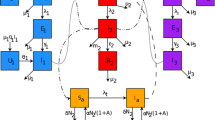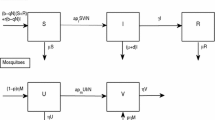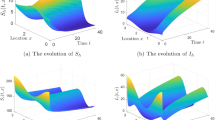Abstract
Rift Valley Fever is a vector-borne disease mainly transmitted by mosquito. To gain some quantitative insights into its dynamics, a deterministic model with mosquito, livestock, and human host is formulated as a system of nonlinear ordinary differential equations and analyzed. The disease threshold \(\mathcal{R}_0\) is computed and used to investigate the local stability of the equilibria. A sensitivity analysis is performed and the most sensitive model parameters to the measure of initial disease transmission \(\mathcal{R}_0\) and the endemic equilibrium are determined. Both \(\mathcal{R}_0\) and the disease prevalence in mosquitoes are more sensitive to the natural mosquito death rate, d m . The disease prevalence in livestock and humans are more sensitive to livestock and human recruitment rates, \(\Uppi_l\) and \(\Uppi_h\), respectively, suggesting isolation of livestock from humans is a viable preventive strategy during an outbreak. Numerical simulations support the analytical results in further exploring theoretically the long-term dynamics of the disease at the population level.


Similar content being viewed by others
References
Barbalat I (1959) Système d’équations différentielles d’oscillation nonlinèaires. Rev Roumaine Math Pures Appl 4:267–270
Bates M (1970) The natural history of mosquitoes. Peter Smith, Gloucester, MA
Bowman C, Gumel A, van den Driessche P, Wu J, Zhu H (2005) A mathematical model for assessing control strategies against West Nile Virus. Bull Math Biol 67:1107–1133
CIA (2007) The world factbook. http://www.cia.gov/cia/publications/factbook/ retrieved 21 August 2008
Chitnis N, Hyman JM, Cushing JM (2008) Determining important parameters in the spread of malaria through the sensitivity analysis of a mathematical model. Bull Math Biol 70:1272–1296
Daubney R, Hudson JR, Garnham PC (1931) Enzootic hepatitis of Rift Valley fever, an undescribed virus disease of sheep, cattle and man from East Africa. J Pathol Bacteriol 34:545–579
Erasmus BJ, Coetzer JAW (1981) The symptomatology and pathology of Rift Valley fever in domestic animals. Contribut Epidemiol Biostat 3:77–82
Gaff HD, Hartley DM, Leahy NP (2007) An epidemiological model of Rift Valley fever. Electron J Differ Equ 2007(115):1–12
Glenda D, Radford D (2007) Rift Valley fever. http://www.cfsph.iastate.edu/diseaseinfo/ppt/RiftValleyFever.ppt#40. Retrieved 28 June 2008
House JA, Turell MJ, Mebus CA (1992) Rift Valley fever: present status and risk to the Western Hemisphere. Ann N Y Acad Sci 653:233–242
Hoogstraal H, Meegan JM, Khalil GM, Adham FK (1979) The Rift Valley fever epizootic in Egypt 1977–78. II. Ecological and entomological studies. Trans R Soc Trop Med Hyg 73:624–629
Jup PG, Kemp A, Globbelaar A, Lema P, But FJ, Alahmed AM, Al Mujalli D, Al Khamees M, Swanepoel R (2002) The 2000 epidemic of Rift Valley fever in Saudi Arabia: mosquito vector studies. Med Vet Entomol 16(3):245–52
Korobeinikov A (2007) Global properties of infectious disease models with nonlinear incidence. Bull Math Biol 69:1871–1886
LaSalle JP (1976) The stability of dynamical systems, CBMS-NSF regional conference series in applied mathematics 25. SIAM, Philadelphia
McCluskey CC (2006) Lyapunov functions for tuberculosis models with fast and slow progression. Math Biosci Eng 3(4):603–614
Meegan JM (1979) The Rift Valley fever epizootic in Egypt 1977–1978. I. Description of the epizootic and virological studies. Trans R Soc Trop Med Hyg 73:618–623
Meegan JM, Bailey CL (1988) Rift Valley fever. In: Monath T (eds) Arboviruses epidemiology and ecology, vol IV. CRC Press, Boca Raton, FL
Moutailler S, Krida G, Schaffner F, Vazeille M, Failloux A-B (2008) Potential vectors of Rift Valley fever virus in the mediterranean region. Vector Borne Zoonotic Dis 8(6):749–753
Mukandavire Z, Garira W, Tchuenche JM (2009) Modelling effects of public health educational campaigns on HIV/AIDS transmission dynamics. Appl Math Model 33:2084–2095
Peters CJ, Linthicum KJ (1994) Rift Valley fever. In: Beran GW (ed) Handbook of zoonoses, B: viral, 2nd edn. CRC Press, Boca Raton, pp 125–138
Pratt HD, Moore CG(1993) Vector-borne disease control: mosquitoes of public health importance and their control. US Department of Health and Human Services, Atlanta, GA
Radostits OM (2001) Herd healthy: food animal production medicine. 3rd edn. W.B. Saunders Company, Philidelphia, PA
Turell MJ, Faran ME, Cornet M, Bailey CL (1988) Vector competence of Senegalese Aedes fowleri (Diptera:Culicidea) for Rift Valley fever virus. J Med Entomol 25(4):94–96
van den Driessche P, Watmough J (2002) Reproduction numbers and sub-threshold endemic equilibria for compartmental models of disease transmission. Math Biosci 180:29–48
WHO (2007) Fact Sheet No.207: Rift Valley fever, http://www.who.int/mediacentre/factsheets/fs207/en/, retrieved 11 July 2008
WHO (2008) Epidemic and pandemic alert and response (EPR), http://www.cdc.gov/ncidod/dvrd/Spb/mnpages/dispages/rvf.htm. Retrieved 28 July 2008
Acknowledgments
Mpeshe would like to thank the following institutions for support: Tumaini University (Iringa University College)-Tanzania, Belgium Technical Cooperation-Tanzania, and Lappeenranta University of Technology-Finland. However, the conclusions are those of the authors and not influenced by any institution. Thanks to the reviewers for constructive comments.
Author information
Authors and Affiliations
Corresponding author
Rights and permissions
About this article
Cite this article
Mpeshe, S.C., Haario, H. & Tchuenche, J.M. A Mathematical Model of Rift Valley Fever with Human Host. Acta Biotheor 59, 231–250 (2011). https://doi.org/10.1007/s10441-011-9132-2
Received:
Accepted:
Published:
Issue Date:
DOI: https://doi.org/10.1007/s10441-011-9132-2




